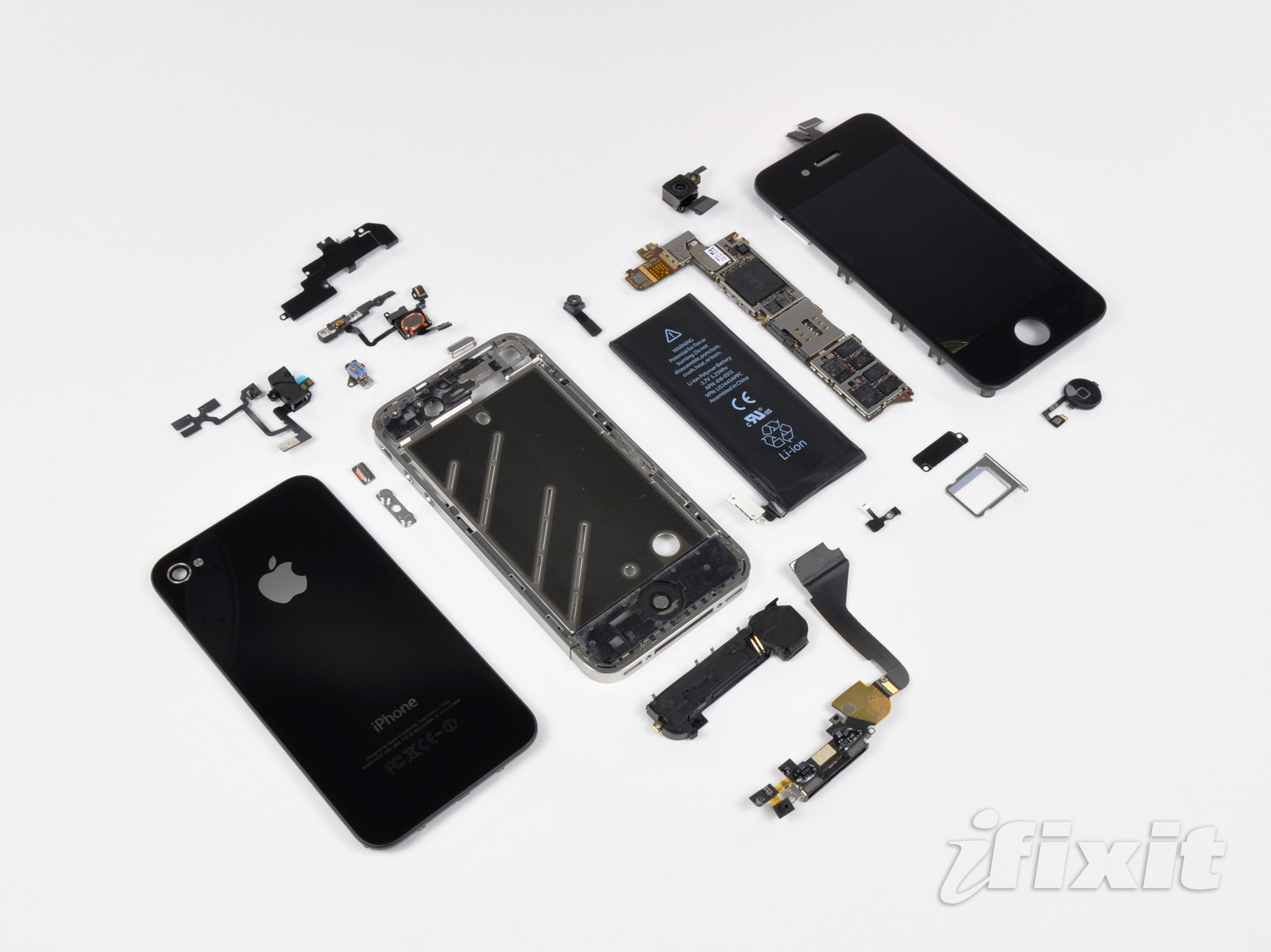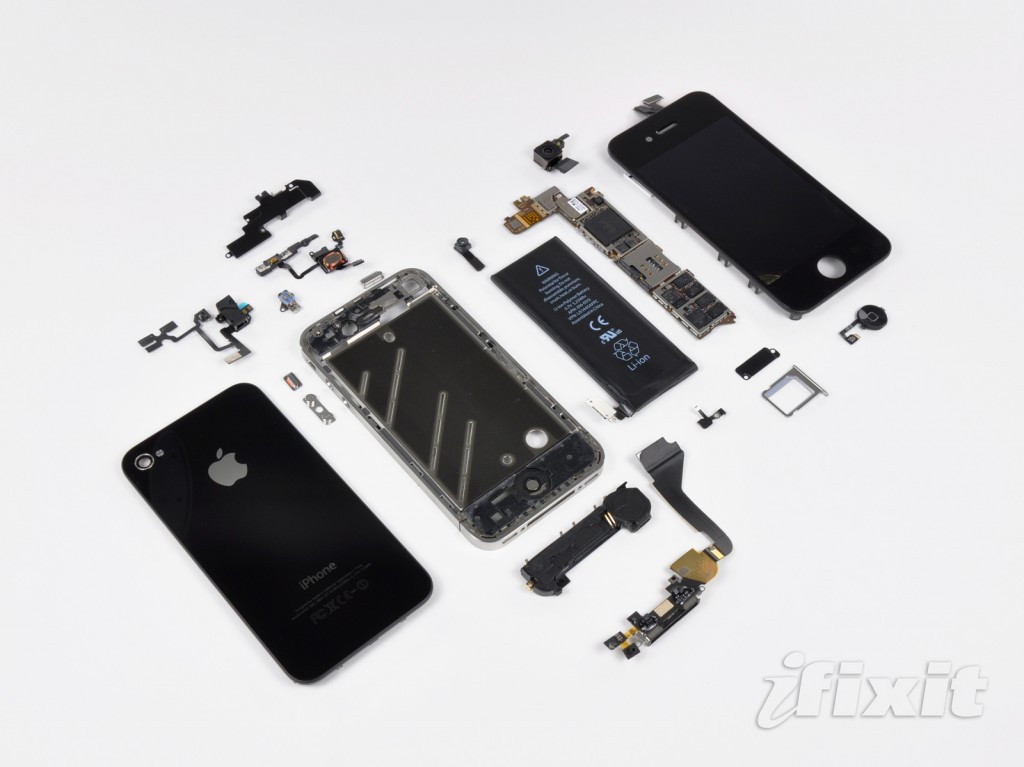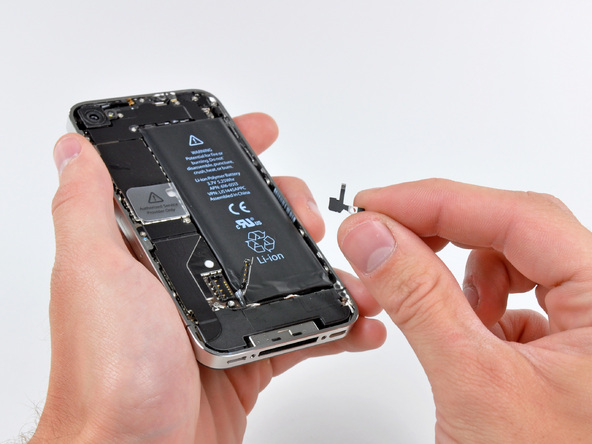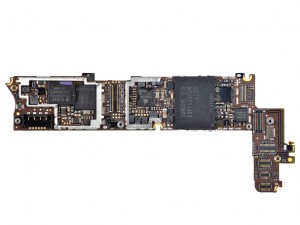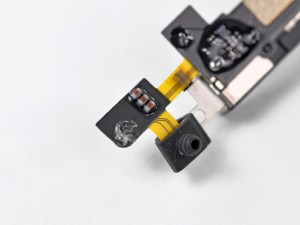The guys over at iFixit and Chipworks have done some excellent teardown work on the Apple iPhone 4 and gotten the full scoop as far as the materials and specs are concerned.
First let’s take a look at the outside (pictures courtesy of iFixit).:
“The rugged stainless steel bezels around the iPhone 4’s perimeter double as both structural supports and antennas to boost reception… The front glass panel of the iPhone is constructed of Corning Gorilla Glass, a chemically strengthened alkali-aluminosilicate thin sheet glass that is reported to be 20 times stiffer and 30 times harder than plastic.”
Next we take a look at the battery and some of the inner components, as you know the iPhone 4 is renowned for the low battery consumption and high performance of its hardware, packed into the thinnest shell a smart-phone has ever housed.
“Luckily, the battery can be easily removed once the back panel assembly is out of the way… The 3.7V 1420 mAh Li-Polymer battery allows for up to 7 hours of talk time on 3G or up to 14 hours on 2G… The battery connector is different than the one in the 3G and 3GS. Fortunately, the battery is not soldered to the logic board.”
Next let’s take a look at the gizzards of this thing! The next 2 pics show the inside of the phone with an interesting configuration. This confirms that the iPhone does house 512MB RAM which is the same as the Evo and HD2 and twice the RAM of the iPad.
“No EMI shield will stand between us and the innards of this iPhone 4!…The logic board is heavily embedded under wires and EMI shields…The increase in RAM allows for a larger amount of cached data allowing for a smoother and faster user experience…In our brief usage, we did notice that the phone is considerably warmer on the right side. This makes sense, as the logic board is located entirely along the right side of the phone…Behold a beauty in the iPhone 4: a rear-facing 5 MP camera with 720p video at 30 FPS, tap to focus feature, and LED flash…”
“The improved audio chamber aids in clarifying sounds leaving the iPhone, including calls via speakerphone as well as music played through the speaker inside this housing…In what can only be described as a work of genius, Apple has integrated the UMTS, GSM, GPS, Wi-Fi, and Bluetooth antennas into the stainless steel inner frame…The dual purpose stainless steel inner frame/antenna assembly addresses possibly the two biggest flaws concerning previous iterations of the iPhone: continuous dropped calls and lack of reception…Apple has gone a step further and tuned the phone to utilize whichever network band is less congested or has the least interference for the best signal quality, regardless of the actual signal strength. Early reports suggest this feature, while buggy in its early stages, will greatly improve the phone’s reliability on AT&T’s fragile network…”
Now let’s take a look at the A4 chip. We finally see exactly how this thing is made up!
“Replacing the Samsung S5PC100 ARM A8 600 MHz CPU used in the 3GS, the new iPhone uses the 1 GHz ARM Cortex A8 core, much like its bigger sibling, the iPad… The A4 is actually much more than just a processor— it’s a Package on Package, or PoP. In fact, there are three silicon dies inside the A4!… This is a cross-section of the iPhone’s ARM processor + RAM package. Click here to see it in its full, 2854×313 glory... Having the RAM so close to the processor both reduces latency—making RAM access faster—and cuts power consumption, helping your battery last longer… The A4 has three layers: Two layers of RAM (Samsung K4X1G323PE), and one layer containing the actual microprocessor… This Package-on-Package construction gives Apple the flexibility to source the RAM from any manufacturer they want—they’re not locked into Samsung… The new Samsung Wave S8500 smartphone uses the same Cortex A8 core!…
Now let’s take a look at some other parts and specs.
“Just to the left of the A4 package, the AGD1 is the new 3 axis gyroscope that we believe is designed and manufactured by ST Micro for Apple. The package marks on this device do not appear to be the currently available commercial part, L3G4200D. The commercial version of this gyroscope is yet to be released — Apple got first dibs on it…STMicro STM33DH 3-axis accelerometer…AKM8975 – newest magnetic sensor that promises to improve the performance over the prior generation….Texas Instruments 343S0499 Touch Screen Controller…we find the second microphone, which is used to cut out ambient noise and improve sound quality when talking on the phone….”
Last we’ll take a look at the Mics on this thing.
“Apple is following in the footsteps of the Nexus One by using dual microphones to help improve audio quality and suppress background noise… Interestingly, the two microphones are positioned at the two far ends of the phone. The microphone at the top of the iPhone is most likely utilized for capturing background noise to be analyzed by internal circuitry and used to cancel any noise put into the main microphone other than the user’s voice…”
So what do you think?
Impressed yet?
Not so much?
What are your thoughts on the hardware of the device? We have had lots of discussion on the software pros and cons. Would you love to see an Android device running this hardware?

